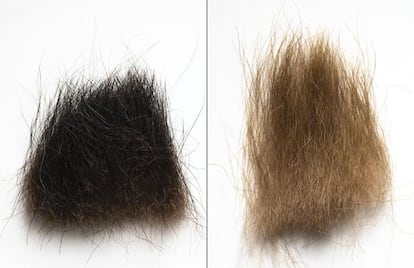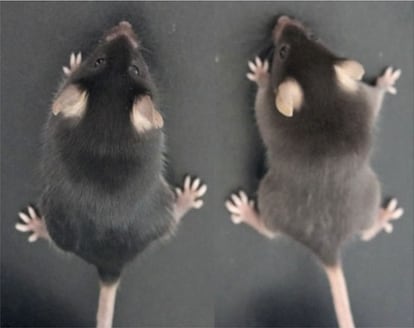The mystery of brown pandas revealed: Their color is due to a mutation
These types of mutations follow Mendelian patterns of inheritance. For the animal to be born brown-white, both its parents must carry the mutation, even if they are black-and-white

In 1985, the first brown panda was observed. The animal was so unique it sparked many wild explanations: it was a fake, its fur was stained, it was a strange case of albinism, it had a genetic alteration. In the end, it was classified as a subspecies of the panda bear Ailuropoda melanoleuca. The animal was called the Qinling panda, because it was found in this mountain range. Now, a fur analysis of two Qinling pandas and the genome of 227 pandas, all black and white except these two, has identified a mutation in a gene that affects their pigmentation, a gene which is inherited from their parents. It is estimated that there are only 100 brown pandas left today.
The first recorded sighting of a brown panda ended with the bear being placed at the zoo in Xi’an, the capital of the Chinese province of Shaanxi, which is famous for its terracotta warriors. For years, they tried to get the panda — who they named Dandan (meaning “the only red one” due to its chestnut coloring) — pregnant. But either she had a miscarriage or her offspring died within a few months. Only one survived, Qinqin, a black and white panda bear, like its father, who also came from the zoo.
Dandan died in 2000 from skin cancer, and Qinqin died shortly after, ending her lineage there. But since then, there have been more sightings of brown pandas in the bamboo forests of the Qinling Mountains, with around a dozen spotted. In 2009, scientists were in luck. In the same area where they found Dandan, they discovered a young male named Qizai, the only brown panda that lives in captivity. A detailed study of Qizai and Dandan, published in the scientific journal PNAS on Tuesday, has revealed the mystery of their color.

By studying the fur of both animals and comparing it with that of the black-and-white pandas, the researchers found that the brown pandas had fewer melanosomes in their fur. These are organelles within the cells of the epidermis that store and synthesize melanin, the pigment present in almost all living beings: in humans, these are largely concentrated in the skin and hair. The melanosomes of brown pandas are also 55% smaller than in humans.
To determine the genetic origin of the brown coloring, the researchers sequenced the genome of all the known relatives of Qizai and Dandan and another dozen pandas from the Qinling Mountains. This was then compared with the genetic data of almost 200 black-and-white pandas from other areas of China. The researchers were looking for something that would make the brown pandas different and they found it: “Based on the pedigree, we conclude that the brown coat color is governed by autosomal recessive mutations,” the scientists write in the study. These types of mutations follow Mendelian patterns of inheritance. For a panda to be born brown-white, both parents must carry the mutation, even if they are black-white.
The next step was to find the mutation responsible for this very special phenotype. Comparing all the sequences, the researchers found that a deletion (loss or deletion of one or more letters or bases from DNA) of 25 base pairs at the start of the Bace2 gene was the possible cause. According to the study, none of the almost 200 pandas in the other mountain ranges, most concentrated in Sichuan, had the mutation. However, several of the pandas from the Qinling Mountains and a hybrid of both populations had the variation. Some were heterozygous, that is, they carried the allele or variation inherited from only one of their parents. Only Qinqin and Dandan were homozygous, meaning they had inherited the mutation from both their mother and father. In other words, it was a recessive mutation, which explains why brown pandas are so rare.

Once the gene was found, the scientists had to confirm that it was responsible for the brown panda’s coloring. To do this, they modified a series of 78 homozygous laboratory mice, all black, with the CRISPR genetic editing technique to delete that part of the Bace2 gene. Mice have a somewhat particular hair cycle, with a phase of growth, another of regression, a third of rest, and another of growth. When compared to the rodents in the control group, the scientists saw that the mutant mice had begun to grow brown fur. “These findings strongly support that this deletion of Bace2 is most likely the genetic basis of brown-and-white coat color in brown pandas,” say the authors of the study, from the Institute of Zoology at the Chinese Academy of Sciences.
This gene expresses a protein present in the cell membrane, with various enzymatic functions. Recently, in humans, Bace2 has been linked to Alzheimer’s. The two brown pandas had normal growth and reproduction systems, just as the mutant mice were also found to be viable, fertile and with no notable physical abnormalities. This indicates that the mutation has no obvious negative impacts. However, the authors conclude, “other physiological impacts of this mutation on the brown pandas remain unclear, as Bace2 is known to be involved in the Alzheimer’s disease pathway.” Any harmful effect could put an end to this oddity of nature.
Sign up for our weekly newsletter to get more English-language news coverage from EL PAÍS USA Edition
Tu suscripción se está usando en otro dispositivo
¿Quieres añadir otro usuario a tu suscripción?
Si continúas leyendo en este dispositivo, no se podrá leer en el otro.
FlechaTu suscripción se está usando en otro dispositivo y solo puedes acceder a EL PAÍS desde un dispositivo a la vez.
Si quieres compartir tu cuenta, cambia tu suscripción a la modalidad Premium, así podrás añadir otro usuario. Cada uno accederá con su propia cuenta de email, lo que os permitirá personalizar vuestra experiencia en EL PAÍS.
¿Tienes una suscripción de empresa? Accede aquí para contratar más cuentas.
En el caso de no saber quién está usando tu cuenta, te recomendamos cambiar tu contraseña aquí.
Si decides continuar compartiendo tu cuenta, este mensaje se mostrará en tu dispositivo y en el de la otra persona que está usando tu cuenta de forma indefinida, afectando a tu experiencia de lectura. Puedes consultar aquí los términos y condiciones de la suscripción digital.
More information
Archived In
Últimas noticias
NASA discovers Titan doesn’t have an ocean, but a ‘slushy ice layer’ that increases possibility of life
Innocence lost in the forest of the child soldiers: ‘Each leader of the armed group had his girls’
‘Fallout’ or how the world’s largest company turned an anti-capitalist apocalyptic Western into a phenomenon
From inflation to defending migrants: Eileen Higgins and Zohran Mamdani inaugurate the new Democratic resistance against Trump
Most viewed
- ‘El Limones’ and the growing union disguise of Mexican organized crime
- Christian Louboutin: ‘Young people don’t want to be like their parents. And if their parents wear sneakers, they’re going to look for something else’
- The low-cost creative revolution: How technology is making art accessible to everyone
- ‘We are dying’: Cuba sinks into a health crisis amid medicine shortages and misdiagnosis
- Liset Menéndez de la Prida, neuroscientist: ‘It’s not normal to constantly seek pleasure; it’s important to be bored, to be calm’











































